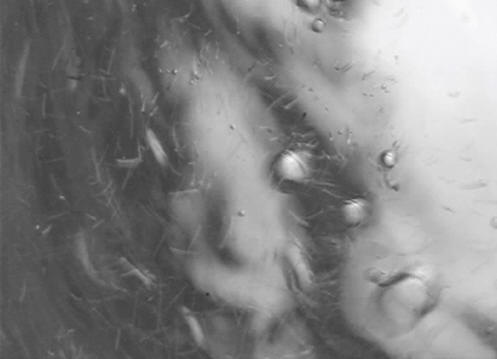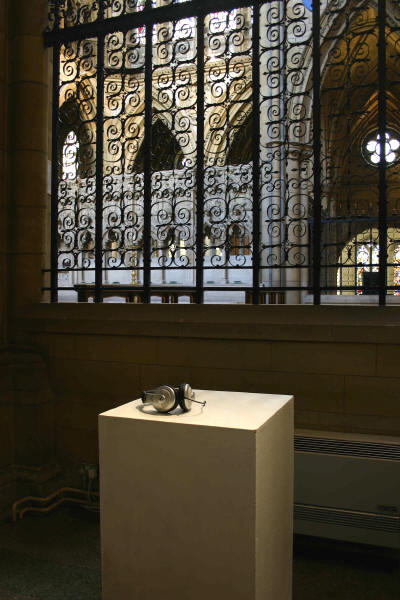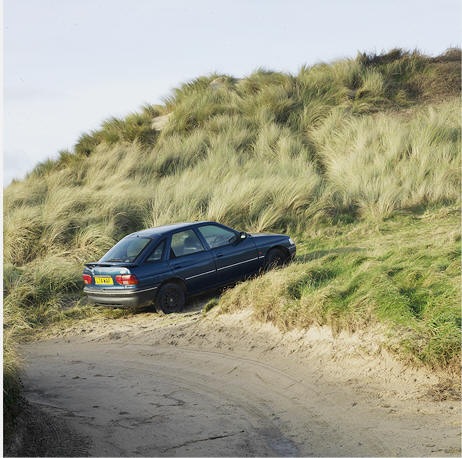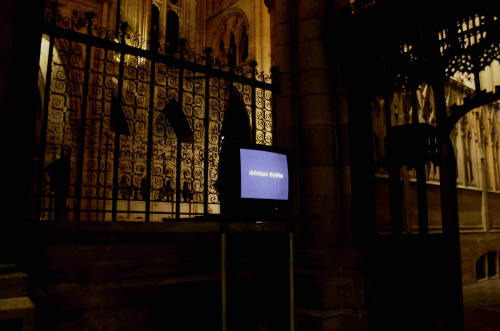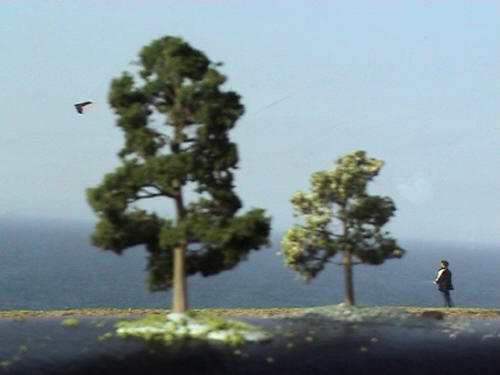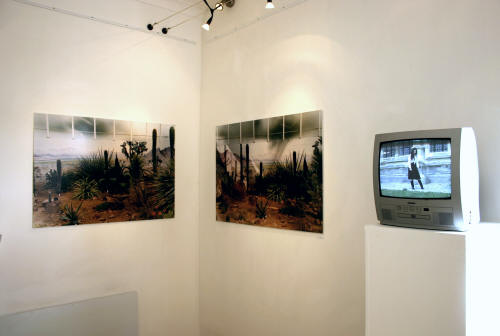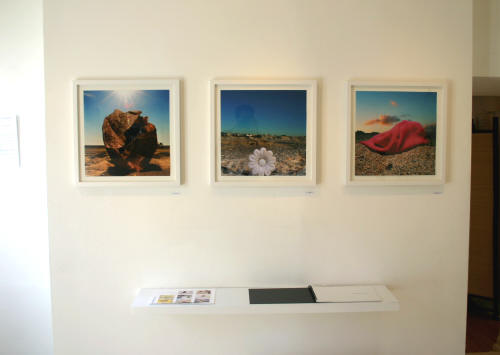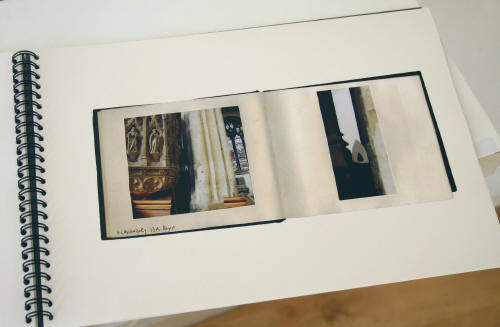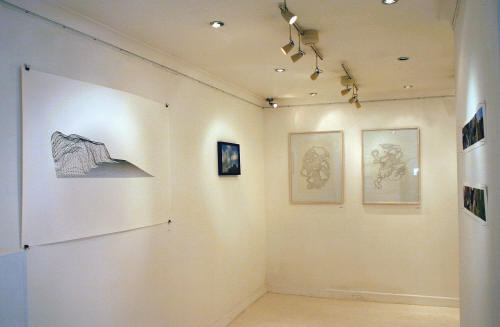|
|
||
| home | features | exhibitions | interviews | profiles | webprojects | gazetteer | links | archive | forum | ||
|
|
||
|
Second Nature Truro Cathedral and Vitreous Contemporary Art, 22nd September - 13th October 2007
Pt 1: Cathedral
I arrived on the opening night of 'Second Nature' at an eerily lit Cathedral in Truro, to be confronted by Andy Whall's ‘In an Atlantic wave’: seen by many as part of the Tate’s Art Now Cornwall. Stretching down the main nave, it was repeated on eight glimmering screens, and walking past each one, the immersive power of the churning underwater sea became hugely magnified.
Two works used the architectural features of the Cathedral to good effect. Rupert White contributed a ghostly and hypnotic projection of a white chough flying high in the eaves of a small side-chapel (below left), and installed under a grill in the floor was a video by Daryl Waller depicting burning embers falling into a deep well (above). Visitors had to step over it, and some stooped or knelt to look more closely.
Stephanie Boon’s ‘Other shores’ (above right) was a sound piece of her son sleeping, with bird song interwoven, which rises as he exhales. I later heard that a mother and father who had lost a child had heard the piece and were highly affected by it. ‘Eccy’ by Andy Hughes (below), a light box photograph of a Ford Sierra abandoned near a sand dune, is part of ‘a sketchbook of wanderings’ recalling an event where the photographer found a person attempting to commit suicide and prevented them, only to discover later that they had later successfully ended their life. It was installed as an altarpiece in the far corner of the building.
On the organ-loft side of the cathedral was Paul Chaney’s ‘African Swifts’ (below), a film originally shot on super8 in 2004; a year in which swift populations were decimated by a unseasonal gales. Nearby was ‘Men and Planes’ by Jacqueline Knight, which featured model aircraft with real men flying them, except that, unknowingly they were framed and made to look unreal by model trees in the foreground of the image (see 'webprojects').
Pt 2: Vitreous The section of the show nearby at Vitreous was very different, but equally compelling, with each of the artists showing in the Cathedral also showing companion pieces at the gallery. These smaller spaces, and the work within, made for a more intimate and introspective display. The first room featured the record of a memorable, though understated, performance outside the Cathedral by Delpha Hudson with Rebecca Weeks and a small but very obliging tortoise (below). Based on the fin-de-siecle idea of the flaneur, the slow pace of the film contrasted tellingly with the busy traffic on the street outside. It also included Jacqui Knight’s photographs of Victorian-style dioramas (below) which were particularly striking. These photographs of animals and plants within man-made environments reminded me of The Eden Project; and a feeling that we console ourselves with a version of nature that we can control.
In the opposite corner were drawings by Daryl Waller (above), photographs from 'Dominant Wave Theory' by Andy Hughes (below top), and an artists book by Paul Chaney (below bottom) recording shrines made for dead bees left in churches all over the south of England.
In the back room, there were still photographs comprising Chaney’s documentation of his ‘Roadkill Graveyard’ pinned simply to the wall (below). I was genuinely moved by this work, perhaps because, for him, it is so much a way of life. One still in this photographic series shows a close-up of Chaney's muddy hand gently lifting the bloody body of a weasel, with flies resting on his skin; gentle and still in respect and contemplation. It is an image which should be ugly, but it had an unbelievable sense of harmony. A piece by Daryl Waller, the digital work ‘You are beautiful’, showed birds on telegraph cables spelling out the title. This very poetic image recalled for me many emotions, and was very uplifting; a sense of personal loneliness and comfort from unexpected sources, and at the same time in contrast a feeling of being at the centre of all things.
Andy Whall’s collage piece was unexpected. Known for his performance works it was unusual to see a work by him in a picture frame. This piece recounted a journey made by Whall following the route of a jewish writer (Walter Benjamin) escaping the Nazis. It felt a little out of place to me, but it displayed undoubted integrity. Canon Philip Lambert in his short essay used the phrase: ‘eat the eyes of Christ’, a quote from mystical theologian Maximus the Confessor. As Lambert states: ‘he meant that we should see and feel creation as a spiritual thing’. Yet arguably throughout this exhibition there is a foreboding sense not of creation but of destruction, and mankind not facing up to its responsibilities.
Without wishing to sound pious or pretentious I have for some time viewed artists as messengers of truth. We live in a time where it seems people are very disillusioned, and I have witnessed and had conversations with many people who visit galleries for spiritual nourishment - often failing to find such nourishment elsewhere. This is when art is working its best, when it points towards the truth, or celebrates creation. I’m pleased to say that I did not find the show ‘radical’ as such. There was an unease verging on apology for this in the guide; almost a government health warning which for me was unnecessary. I would imagine that this show may be seen as uncommercial, for which Jake Bose at Vitreous deserves an awful lot of credit. I however found many works that would be enriching to have around me, so would urge people to see both exhibitions and, if they are able to do so, to support both the venues and artists for this thought-provoking and at times very moving exhibition by buying work. In this day and age where funded artists and projects seem to be taking over and are mostly, in my view, emotionally unaffecting, this show deserves success and attention. It is a testament to genuine desire to say something meaningful from the artists themselves and not the arts council funded administrations or organisations that for me so often miss the point. With this two-centre exhibition the point was well made.
Joseph Clarke
|
||

